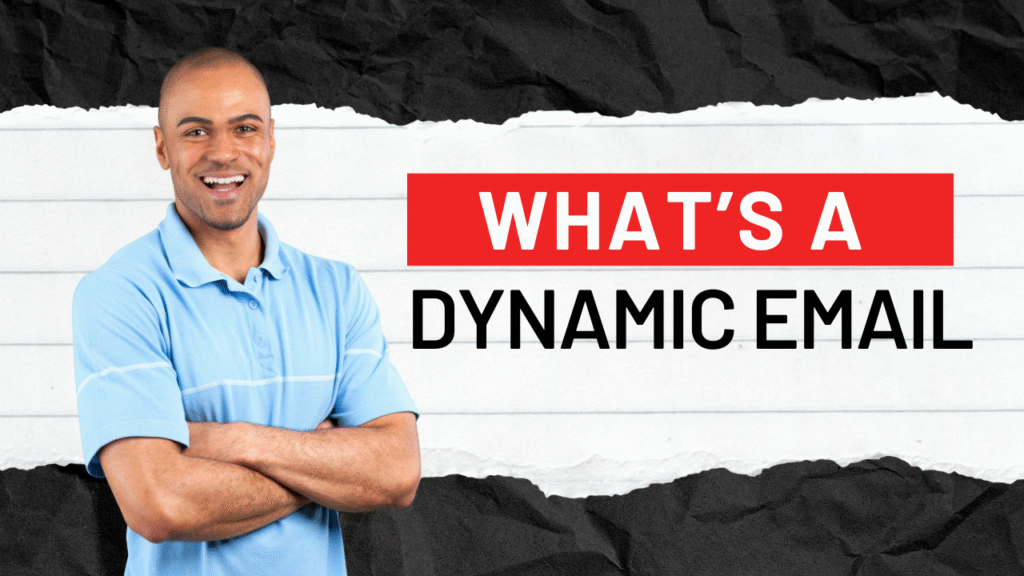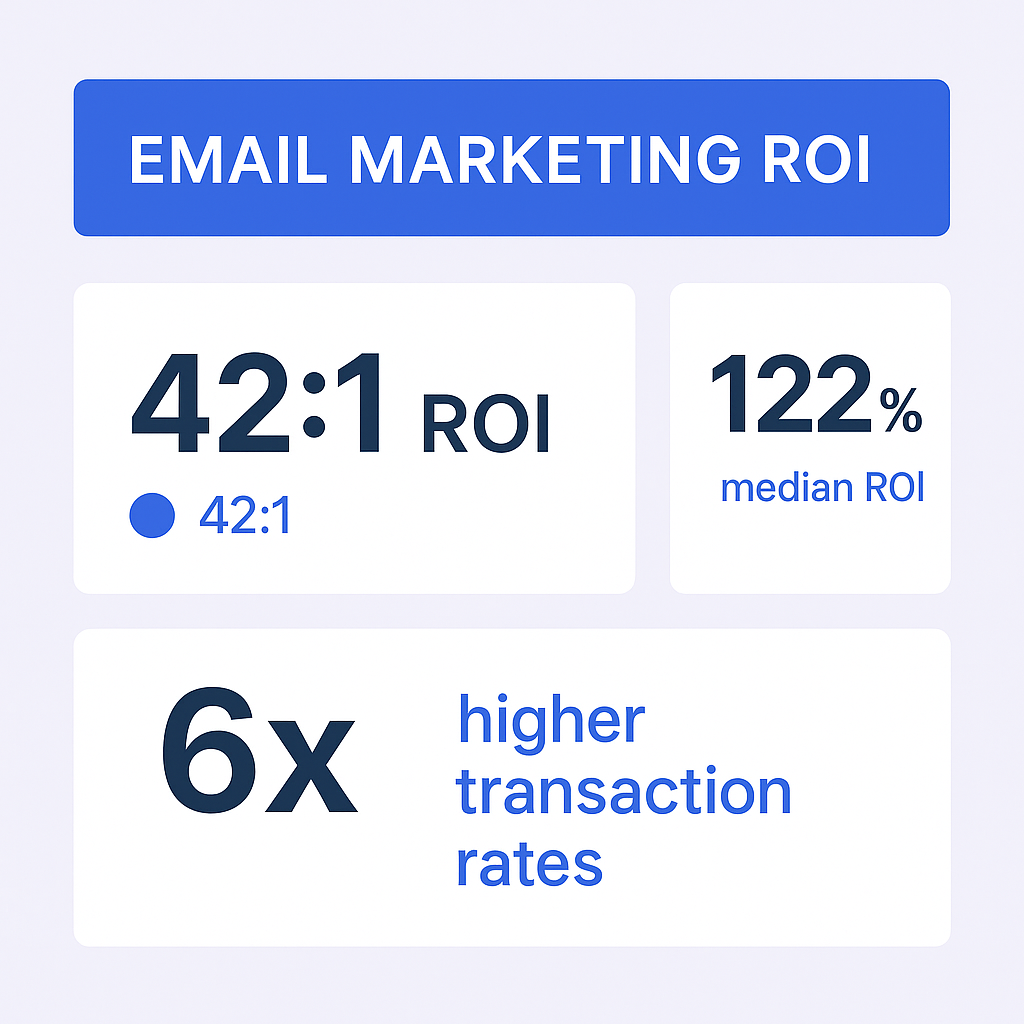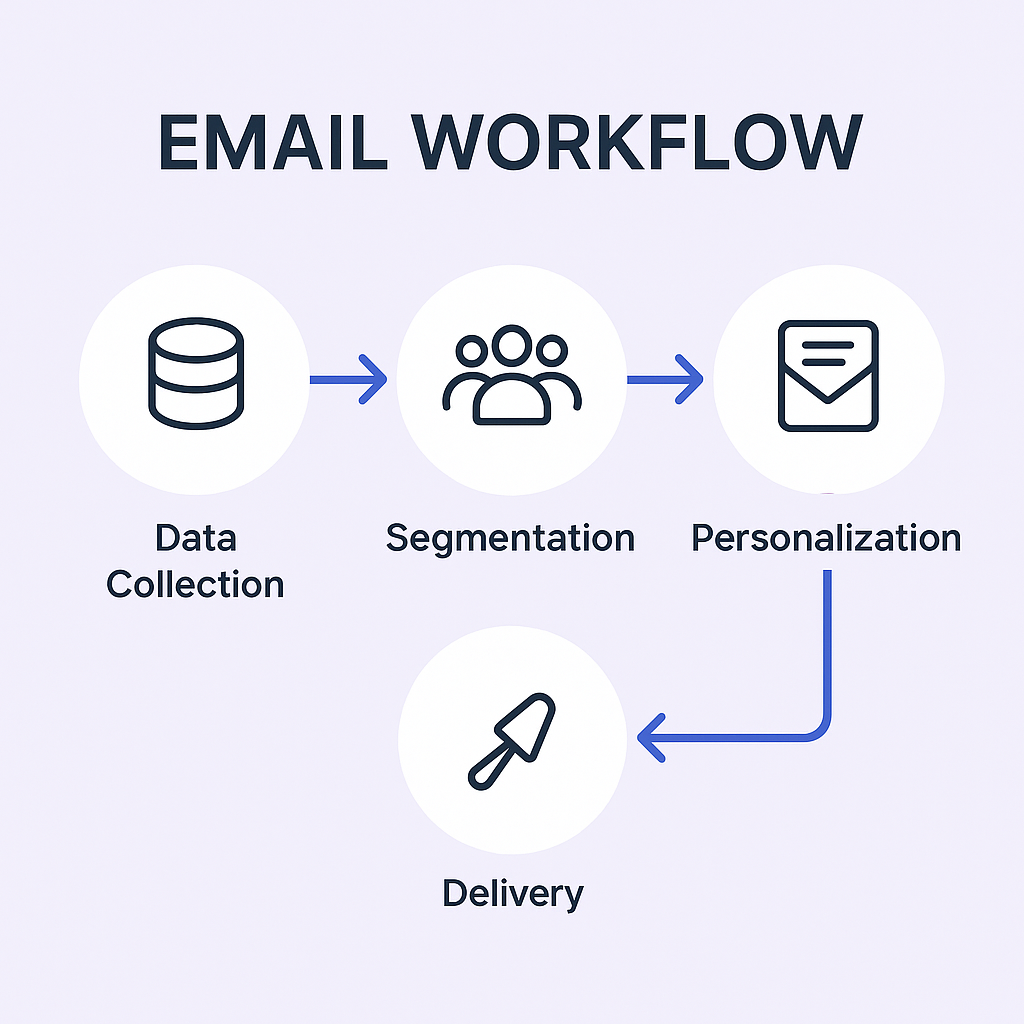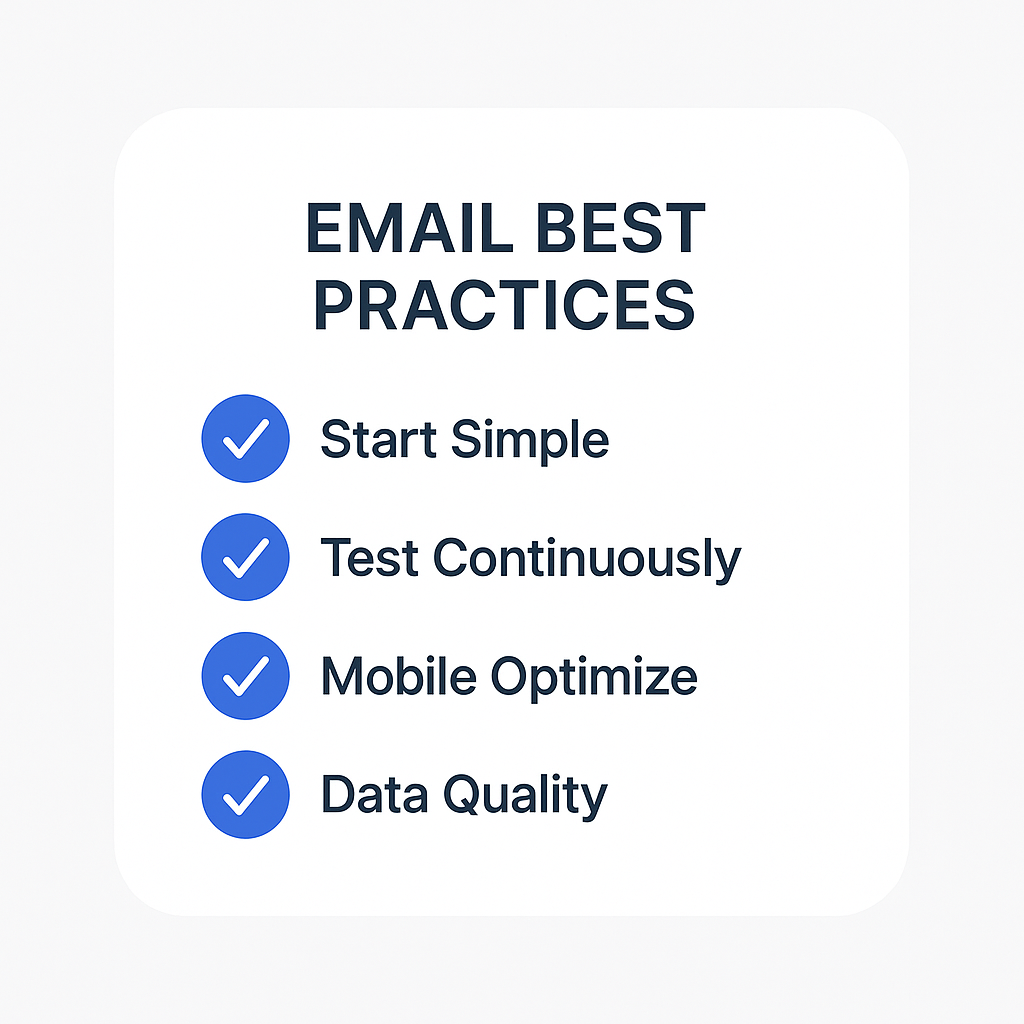- blog
- Email Deliverability
- What’s a Dynamic Email? Complete Guide for Sales Success 2025

What's a Dynamic Email? Your Complete Guide to Email Marketing Excellence
Table of Contents
In today’s hyper-competitive digital landscape, where 4.5 billion people use email globally and over 376 billion emails are sent daily, standing out in crowded inboxes has never been more challenging. The solution? Dynamic email content – a game-changing approach that’s revolutionizing how businesses connect with their audiences.
Dynamic email content refers to email elements that automatically adapt and change based on the recipient’s data, behavior, or preferences. Unlike static emails that deliver identical messages to everyone, dynamic emails create personalized experiences that feel tailor-made for each individual recipient.
What is Dynamic Email Content?
Dynamic email content is any element within an email that intelligently adapts based on who’s receiving the message. Think of it as having a personal conversation with each subscriber, where the content changes to match their interests, location, purchase history, or browsing behavior.
64% of emails sent by companies leverage personalization using dynamic content, making it one of the most effective tactics in modern email marketing. From simple name personalization to complex behavioral triggers, dynamic content transforms generic broadcasts into relevant, engaging communications.
Key Characteristics of Dynamic Email:
- Adaptive content that changes based on recipient data
- Real-time personalization using behavioral triggers
- Segmented messaging tailored to specific audience groups
- Interactive elements that engage recipients directly
- Contextual relevance based on location, time, or preferences
Why Should You Use Dynamic Email Content?
The statistics speak volumes about the impact of dynamic email content on business results. Personalized emails deliver 6x higher transaction rates, while segmented, personalized and targeted emails generate 58% of all revenue.
Dramatic Engagement Improvements
Email subject lines that are personalized generate an average of 50% higher open rates, and personalized email marketing generates a median ROI of 122%. Even more impressive, brands that include dynamic email content always generate an ROI of 42:1, compared to an ROI of 21:1 for those who never or rarely employ dynamic content.
Enhanced Customer Experience
90% of U.S. consumers find marketing content personalization “very” or “somewhat” appealing, and 62.26% of consumers feel “happy” and “excited” to respond to a personalized message from a retailer. This emotional connection translates into stronger customer relationships and increased brand loyalty.
Time and Resource Efficiency
Dynamic content allows marketers to create one master template that adapts to different segments, saving countless hours compared to creating individual campaigns for each audience group. Automated emails generate 320% more revenue compared to non-automated emails, highlighting the efficiency gains from dynamic content implementation.
🚀 Authentic Beats Automated Personalization
LinkedIn outbound creates genuine business relationships without dynamic content complexity
Types of Dynamic Email Content
Text Personalization
The foundation of dynamic content starts with personalized text elements. This includes inserting recipient names, company information, job titles, and location data throughout the email copy and subject lines. Emails with personalized subject lines get a 26% boost in open rates, making this the most accessible entry point for dynamic content.
Examples:
- “Hey {FirstName}, your {City} exclusive offer!”
- “Special promotion for {Company} this week”
- “{FirstName}, here’s what’s trending in {Industry}”
Dynamic Visuals
Visual elements that change based on recipient data create powerful engagement. Including videos in your email content can increase your click rates up to 300%, while brands that leverage animated GIFs often or always saw an ROI of 37:1, compared to an ROI of 18:1 for those who never include animated GIFs.
Types of dynamic visuals:
- Product images based on browsing history
- Gender-specific product showcases
- Location-based imagery (weather, local events)
- Animated GIFs and interactive carousels
- Real-time pricing and inventory updates
Personalized Calls to Action
Dynamic content can improve click-to-open rates by as much as 73%, with much of this improvement coming from tailored calls-to-action (CTAs). Smart CTAs adapt based on where the recipient is in the customer journey, their engagement level, or their specific needs.
Examples:
- “Download our {Industry} guide” for prospects
- “Reorder your favorites” for existing customers
- “Try {ProductName} free for 30 days” for specific segments
How Does Dynamic Email Content Work?
Collect Data
The foundation of dynamic email is robust data collection. This includes:
- Demographic information: Age, gender, location, job title
- Behavioral data: Website visits, email engagement, purchase history
- Preference data: Stated interests, content preferences
- Transactional data: Past purchases, abandoned cart items
- Engagement metrics: Open rates, click patterns, device usage
Segmentation
Once data is collected, audiences are divided into meaningful segments. Segmented email campaigns show 50% higher CTR than untargeted campaigns. Effective segmentation criteria include:
- Lifecycle stage: New leads, active customers, at-risk accounts
- Engagement level: Highly engaged, moderate, inactive subscribers
- Purchase behavior: Frequent buyers, one-time purchasers, browsers
- Demographics: Industry, company size, geographic location
- Preferences: Product interests, content types, communication frequency
Customize Dynamic Email Messages for Each Segment
With segments defined, content is created that speaks directly to each group’s needs and interests. This involves:
- Writing segment-specific copy that addresses unique pain points
- Selecting relevant product recommendations
- Choosing appropriate imagery and design elements
- Crafting compelling CTAs that match the segment’s journey stage
- Setting up conditional logic for content display
📧Direct Access Beats Data Segmentation
LinkedIn outbound connects with decision-makers personally without behavioral tracking or content automation
Examples of Dynamic Email Content
H&M Fashion
H&M leverages dynamic content to create personalized shopping experiences. Their emails adapt product recommendations based on:
- Previous purchase history
- Browsing behavior on their website
- Size and style preferences
- Seasonal trends in the customer’s location
The result is highly relevant product showcases that feel curated specifically for each customer, driving both engagement and sales.
Apollo
As a leading sales intelligence platform, Apollo demonstrates dynamic email excellence in their own outreach campaigns. They use:
- Personalized messaging based on company size and industry
- Dynamic case studies relevant to the prospect’s sector
- Tailored product features highlighting solutions for specific use cases
- Behavioral triggers based on platform usage and engagement
Simon & Schuster
The publishing giant uses dynamic content to connect readers with books they’ll love:
- Personalized book recommendations based on reading history
- Genre-specific newsletters tailored to individual preferences
- Author spotlights matching reader interests
- Dynamic pricing and promotional offers based on purchase behavior
Get the Most Out of Your Dynamic Content
Start with Clear Goals
Define what you want to achieve with dynamic content:
- Increase open rates and engagement
- Boost conversion rates and sales
- Improve customer retention and loyalty
- Reduce unsubscribe rates
- Enhance overall customer experience
Focus on Data Quality
20% of marketers find gathering target audience data for segmented campaigns challenging. Invest in:
- Robust data collection processes
- Regular data cleaning and validation
- Integration between marketing and sales systems
- Progressive profiling to gather more information over time
Test and Optimize Continuously
Run A/B tests on your emails often to help increase email ROI by 82%. Brands that often include A/B testing as a part of their email program generate an ROI of 42:1, compared to an ROI of 23:1 for those who never A/B test their emails.
Test elements like:
- Subject line personalization
- Content relevance and messaging
- CTA placement and copy
- Send times and frequency
- Visual elements and design
Implement Mobile Optimization
Mobile devices account for 60% of all email opens in 2025. Ensure your dynamic content:
- Displays properly on all device sizes
- Loads quickly on mobile connections
- Maintains personalization across platforms
- Provides easy interaction on touchscreens
Leverage Automation
Using email as part of a data-driven, personalized campaign achieved a 72X ROI and a 25% increase in CLTV. Set up automated workflows that:
- Trigger based on specific behaviors
- Nurture leads through the sales funnel
- Re-engage inactive subscribers
- Cross-sell and upsell existing customers
⚡ Skip the Personalization Technology
LinkedIn outbound delivers results without dynamic content systems or data integration complexity
Dynamic Email for Sales Teams
Streamlining BDR Workflows
Business Development Representatives can leverage dynamic email to:
- Personalize outreach at scale using company and contact data
- Trigger follow-up sequences based on prospect behavior
- Customize messaging for different industries and company sizes
- Track engagement to prioritize the hottest leads
Personalized cold emails can boost response rates by 30.5%, making dynamic content essential for modern sales development.
Empowering Account Executives
Account Executives benefit from dynamic content through:
- Warmer handoffs from BDRs with detailed engagement history
- Personalized proposal content based on discovered needs
- Automated nurture sequences for long sales cycles
- Dynamic case studies and testimonials relevant to each prospect
Improving Sales and Marketing Alignment
Dynamic email creates shared data and insights that improve collaboration:
- Common understanding of lead scoring and qualification
- Shared metrics on content performance and engagement
- Unified approach to customer journey mapping
- Coordinated messaging across all touchpoints
For sales teams looking to implement dynamic email effectively, check out our guide on creating effective drip campaign flowcharts to map out your automated sequences.
Key Statistics You Need to Know
Engagement Metrics
- The average open rate for personalized email is 188%
- In 2025, the average open rate for brands is 22%
- Open rates jumped 6% YoY, reaching 26.6% in 2024
- Emails with a single CTA tend to have a 371% higher click-through rate
ROI and Revenue Impact
- Email marketing has an ROI of 4200%, which is $42 for every $1 spent
- Dynamic email content can drastically improve your email marketing ROIs and user engagement
- Companies who customize experiences report seeing a 19% uplift in sales on average
- Brands that use live content in their emails often or always report an ROI of 56:1
Personalization Impact
- 65% of email marketers say dynamic content is the most effective personalization tactic
- 80% of email marketing professionals report that personalization tactics improve performance
- 68% of email marketing professionals say that dynamic content personalization improves an email’s performance
B2B Specific Data
- Half of US B2B marketers agree that email is the most impactful tool in their multichannel marketing strategy
- 77% of B2B consumers prefer to be contacted via email
- B2B marketing emails have a 23% higher click-to-open ratio compared to B2C marketing emails
Understanding how to verify email addresses becomes crucial when implementing dynamic content, as data quality directly impacts personalization effectiveness.
Best Practices for Implementation
Start Simple, Scale Gradually
Begin with basic personalization like name and company insertion, then gradually add more sophisticated elements:
- Basic text personalization (names, companies)
- Segmented content blocks (industry-specific messaging)
- Behavioral triggers (browsing history, engagement level)
- Advanced dynamic elements (real-time pricing, live content)
Maintain Data Privacy and Compliance
With increasing privacy regulations, ensure your dynamic email practices:
- Comply with GDPR, CAN-SPAM, and other relevant laws
- Provide clear opt-in and opt-out mechanisms
- Respect subscriber preferences and frequency limits
- Maintain transparent data usage policies

Focus on Value, Not Just Personalization
74% of people hate being shown irrelevant content. Ensure your dynamic content:
- Solves real problems for recipients
- Provides genuine value and insights
- Respects the recipient’s time and attention
- Builds trust through consistent, helpful messaging
🎯 They Want Business Conversations
LinkedIn outbound connects where professionals expect networking, not marketing automation
7-day Free Trial |No Credit Card Needed.
Common Mistakes to Avoid
Over-Personalization
While personalization is powerful, overdoing it can feel creepy or invasive. Avoid:
- Using overly specific personal information
- Referencing private browsing behavior too explicitly
- Making assumptions based on limited data
- Creating content that feels stalky rather than helpful
Neglecting Mobile Experience
47% of consumers view their email app on their phone. Ensure your dynamic content:
- Loads quickly on mobile devices
- Displays properly across different screen sizes
- Maintains functionality on touchscreens
- Provides easy interaction with dynamic elements
Ignoring Data Hygiene
Poor data quality undermines dynamic content effectiveness. Regularly:
- Clean and validate email lists
- Update contact information and preferences
- Remove inactive or bounced email addresses
- Merge duplicate contact records
For guidance on maintaining email deliverability, read our comprehensive guide on email bounce back prevention and management.
Future of Dynamic Email
AI-Powered Personalization
Artificial intelligence is revolutionizing dynamic email content through:
- Predictive analytics for content recommendations
- Automated A/B testing and optimization
- Real-time content generation based on behavior
- Advanced segmentation using machine learning
Interactive Email Elements
The future includes more interactive features:
- AMP for Email enabling app-like experiences
- Real-time updating content that changes after sending
- Interactive surveys and polls within emails
- Shopping capabilities directly in the inbox
Privacy-First Personalization
As privacy regulations evolve, dynamic email will adapt through:
- Zero-party data collection strategies
- Consent-based personalization
- Transparent data usage policies
- Privacy-preserving personalization techniques
Conclusion
Dynamic email content isn’t just a nice-to-have feature – it’s becoming essential for email marketing success. With 64% of emails sent by companies leveraging personalization using dynamic content and clear evidence of dramatically improved ROI, businesses that fail to adopt dynamic strategies risk being left behind.
The key to success lies in starting with clear goals, investing in quality data collection, and continuously testing and optimizing your approach. Whether you’re a BDR looking to improve cold email response rates, an AE nurturing prospects through long sales cycles, or a marketer building customer relationships at scale, dynamic email content offers a path to better results.
Remember, the goal isn’t just personalization for its own sake – it’s about creating more relevant, valuable experiences that benefit both your business and your recipients. When done right, dynamic email transforms impersonal broadcasts into meaningful conversations that drive engagement, build relationships, and generate revenue.
Start implementing dynamic content today, and join the growing number of businesses seeing significant improvements in their email marketing performance. The future of email is dynamic, personalized, and results-driven – make sure you’re part of it.
Frequently Asked Questions
How does LinkedIn outbound compare to sophisticated dynamic email campaigns for B2B sales?
How much does dynamic email content cost to implement?
Can dynamic email content work for small businesses?
How do I measure the success of dynamic email campaigns?
What data do I need to start with dynamic email content?

Why Choose? LinkedIn Outbound Beats Both.
LinkedIn outbound delivers authentic interactions without complex personalization technology or data management
